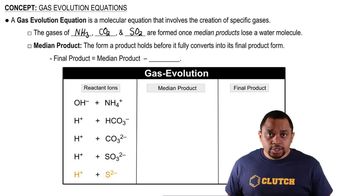Here are the essential concepts you must grasp in order to answer the question correctly.
Acid-Base Reactions
Acid-base reactions involve the transfer of protons (H+) between reactants. In the case of baking powder, the acidic component reacts with baking soda (sodium bicarbonate) to produce carbon dioxide gas. Understanding the nature of acids and bases, including their dissociation in water, is crucial for writing balanced equations.
Recommended video:
Net Ionic Equations
A net ionic equation represents the actual chemical species that participate in a reaction, omitting spectator ions that do not change during the reaction. To write a net ionic equation, one must first identify the soluble ionic compounds and their dissociated ions in solution, then eliminate the spectator ions to focus on the ions that form the products.
Recommended video:
Gas Evolution Reactions
Gas evolution reactions occur when a chemical reaction produces a gas as one of the products. In the context of baking powder, the reaction between sodium bicarbonate and an acid generates carbon dioxide gas, which is responsible for the leavening effect in baking. Recognizing the formation of gases is essential for understanding the overall reaction and its implications in cooking.
Recommended video:
 Verified step by step guidance
Verified step by step guidance

